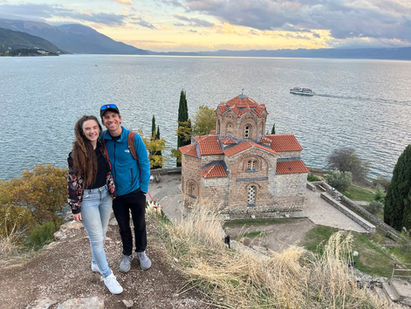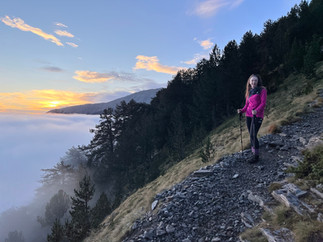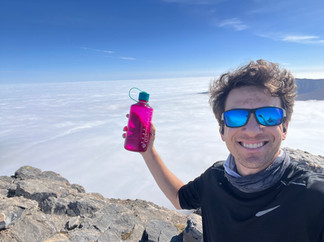



Aug 1512 min read



Leaving North Macedonia behind felt a little bittersweet. We’d loved our time in Ohrid. Lazy lake days and a pace of life that reminded us the joys of slowing down. But as much as we enjoyed it, the road was calling again. Our next chapter? Back into the European Schengen Zone headed for Northern Greece. A region also called Macedonia and definitely not the same as the country of North Macedonia.
Luke and Jelley had to separate momentarily as Luke needed to complete some visa administration. We recently discovered that Luke actually qualified for a niche working visa - Subclass 461 - A Partner of a New Zealander Work Visa in Australia. The visa allows partners of New Zealanders to live / work in Australia for up to 5 years, so we figured why not? Luke did all the paperwork, but the Australian government required some biometric data (fingerprints) which could only be done in an Australian authorized biometric data collection centre. These are all over the world, but none in North Macedonia or Northern Greece, so the closest he could find was in Albania! Go figure haha. So as we set off from Lake Ohrid, Luke made a quick pit stop in Tirana, Albania while Jelley continued directly to our next destination together — Greece!






Jelley had a comfortable 4 hour bus Journey from Ohrid to Greece. All seemed routine until she heard the driver call out:“New Zealand??” Uh oh. Her passport was getting special attention. Thanks to her longer-than-usual Schengen stay this year while working in Germany, the Greek immigration officers had a couple of questions. Thankfully, it was resolved quickly, but not without a moment of sweaty-palmed suspense. To add to the drama, she realized she was also still carrying Luke’s old German residence card in her wallet. Not ideal, considering he’d also be re-entering the EU in just a few days. Here’s hoping Greek border control wasn’t feeling too strict that day!
When most people think of Greece, their minds jump straight to whitewashed island villages, turquoise seas, and endless sandy beaches. What often gets overlooked is that Greece also has a northen mainland which is a rugged region of mountains, gorges, and striking rock formations that feels worlds apart from the postcard-perfect islands. Northern Greece is also layered with history. This land has been walked, fought over, and shaped by Macedonians, Thracians, Romans, Byzantines, Slavs, and Turks, each leaving their own cultural imprint. You can still feel their presence in the architecture, the ruins, and the food. It is a living melting pot of history which we were excited to explore together!






With Luke's visa admin completed, #akiwiandacali were reunited in Greece's second-largest city, Thessaloniki! The city immediately won us over with its energy: buzzing streets, seaside promenades, and a generally cool vibe that made us feel like we had landed in exactly the right place. Even figuring out the local public buses felt like a little victory, which is no small feat in a new country.
Thessaloniki was full of interesting surprises. With a population of around 1 million people, Thessaloniki is known as Greece’s "cultural capital". It pulses with music and film festivals, lively nightlife, and a food scene famous for spanakopita pastries, seafood, souvlaki, and of course, gyros. We made the controversial call to take a break from the city walking tours and explore at our own pace! History is everywhere in Thessaloniki and it feels like an open-air museum. The city has more Byzantine churches than almost anywhere else in the world and streets still echo with Roman and Ottoman influence. Thessaloniki is also closely linked to Alexander the Great, whose kingdom began in this region of "Macedonia" (the Greek part - not "Northern Macedonia" - still confusing). Today locals wander past the Roman ruins, sip coffee along the waterfront, or enjoy the sunset. A neat blend of the ancient and the modern.






Of course, our first stop in Thessaloniki was a local Greek bakery for some fresh spanakopita. The place Jelley found had a buffet-style, pay-per-plate setup, making it perfect for sampling a variety of Greek dishes, all absolutely delicious. There is something about Greek food that feels so much fresher and more flavorful than anywhere else. We tried dolmas, moussaka, a few other spinach-based dishes, and of course some freshly baked bread. It was easy to get carried away with such irresistible cuisine.




We wandered down towards the waterfront and could just make out a faint outline of Mt. Olympus in the distance. We passed the "White Tower", Thessaloniki’s most iconic landmark, which served as a Byzatine fortress and then a prison over the centuries. From there, we explored some nearby palace ruins before hiking up the hill to take in the panoramic views. Unfortunately, many of Thessaloniki’s attractions are closed on Tuesdays, so we focused on the sights that were open. We spent the rest of the evening strolling along the waterfront, enjoying the beautiful sunset, and soaking in the city’s vibrant energy as it settled around us.










The next day we picked up a rental car for a little road trip adventure! The car reminded us a bit of Jelley’s old Honda Logo from our New Zealand road trips - the perfect size for 2 people. It felt amazing to be behind the wheel again, ready to explore at our own pace. After navigating some of Thessaloniki’s chaotic traffic, we finally made our way out of the city and headed toward the famed Halkidiki Peninsula, a favorite getaway for Greeks. The peninsula is nicknamed the “three fingers,” because of it's 3 unique peninsulas - Kassandra, Sithonia, and Athos, each jutting out into the Aegean Sea.




The drive out was stunning. Olive groves stretched as far as the eye could see, and the landscape looked surprisingly dry, with massive facilities for processing olive oil dotted the countryside. Farther out, the peak of Mt. Athos rose dramatically on the third finger-like peninsula, also called "Athos". For religious reasons, no females are allowed to enter the peninsula, not even female animals are allowed. The monks that inhabit the peninsula have kept this tradition for over a thousand years, which is impressive in terms of dedication, but perhaps a little behind the times...




Because of the "boys only" rules on Athos, we opted to drive out to the 2nd finger-peninsula, Sithonia. We drove about three quarters of the way down the east coast of the finger which was an absolutely spectacular drive. We stopped in a quaint seaside town called Sarti. With just 1,500 year-round residents, it felt charmingly quiet, yet the owner of our accommodation laughed at us as he told us that tens of thousands of tourists flooded the town a few weeks ago. Just the week before we arrived, there had been 17 coaches of Serbian and Romanian visitors so we we were quite pleased to have arrived towards the end of the tourist season. Despite the seasonal surge, Sarti’s seaside charm, friendly locals, and slow pace made it the perfect base for a few days.












The next day was a little overcast, but perfect for a drive down the southern part of the peninsula. Purple heather lined the roadside, which felt surprising for mid-October, especially since we had also seen it blooming in Scotland six weeks earlier! It was funny to realize we were really following the seasons.
We took a lovely hike to the southernmost tip of the Sithonia finger, winding through olive groves and arriving at an unusual sandbar. On one side, waves crashed energetically, while the other side was completely calm. We figured it must have had something to do with the winds and currents of the Aegean sea. Luckily, Luke had done some research beforehand, and we parked just off the main highways instead of attempting the sketchy road others had tried to drive. Walking was definitely the safer choice, and while we had heard rumors about wild dogs in the area, we thankfully had no scary encounters.












We continued our drive around the peninsula to complete the circuit. The southern coast felt rugged and untamed, but as we reached the northern towns, the scenery shifted to seaside apartments and resorts. With the season over, the streets were eerily quiet, yet it was easy to picture them pumping with life during summer. That night, back in our cozy beach-side accommodation in Sarti, we were treated to an incredible moon-rise over Mount Athos. The following morning we also caught a fiery sunrise. With no one else around, it felt like we had our own private show from our beachfront balcony.








We reluctantly said goodbye to Halkidiki and drove back past Thessaloniki toward a small town with a very big name in history: Vergina. Vergina pronounced “Ver-YEE-na” in Greek, with the soft "g" sounding like a "y", so it thankfully avoids an awkward English mix-up. At first glance it looked like any other quiet town, but beneath its rolling hills lies one of the most important archaeological discoveries of the 20th century!




In 1977, archaeologists uncovered the tomb of King Philip II of Macedon, the father of Alexander the Great. Hidden beneath the tomb is a massive burial mound that somehow remained untouched for centuries, dodging the raids that so many other sites suffered during Ottoman times. When it was discovered, nearly everything was found remarkably intact, with weapons, jewelry, and treasures lying undisturbed for over 2,000 years. Pretty cool! Inside, behind temperature-controlled glass, we could see the artifacts up close, from golden wreaths to intricate armor. The whole setup felt more like stepping into a time capsule instead of a museum.






If you’re anything like us, you probably have no idea what the Kingdom of Macedon actually is, so here’s the short version. Philip II ruled The Kingdom of Macedon (otherwise known as "Macedonia") from 359 to 336 BC (that's about 300 years before The Roman Empire - so a bloody long time ago!). Philip II transformed the kingdom from a small, rough-around-the-edges city state, into the dominant power of the Greek-city states that existed at the time. His reign ended abruptly when he was assassinated, not long after controversially portraying himself as the “13th God,” a move that ruffled more than a few feathers in his day. His son, Alexander the Great, born in 356 BC, would go on to build one of the largest empires in history, but it was Philip II who laid the foundations. This tomb we visited was part of a larger royal burial site at Vergina, a necropolis (or noble burial site), which included at least 2 other tombs containing members of the royal family / high-ranking nobles. Walking through the museum felt a lot like visiting Egypt’s Valley of the Kings. We left feeling grateful we made the stop to witness it.






Speaking of Ancient Greece, a trip to Northern Greece would not be complete without a visit to the realm of the gods - Mount Olympus! Standing 2,918 meters (9,573 feet) tall, it is the tallest mountain in Greece and was considered the legendary home of the 12 Olympian Gods, including Zeus, Hera, and Athena. We were eager to explore its trails, take in the breathtaking views, and experience a place that has captivated people since ancient times.






Our first stop was the Olympus National Park Information Center, which immediately set the tone for our adventure. The center itself was quite impressive, with clear displays and plenty of information about the mountain and hiking trails. A very helpful staff member walked us through our options and warned us of the risks for the upcoming hike. Since it was one of the last days of the season before snow would close the refuges (huts), her advice was invaluable. She recommended avoiding the highest of the three peaks due to rockfall and tricky scrambles, guidance we were grateful to follow.
Afterwards, we made our way to a charming little accommodation in the nearby town of Leptokorya. The owner was incredibly friendly, offering complimentary Greek snacks and even a bottle of his favourite wine. We were able to keep our room and all our belongings there while we hiked, which made life much easier. The beachfront town was mostly shut up for the season, with shutters down and just a couple of pizzerias still open - we had the place to ourselves! As the clouds lifted briefly over the towering mountains in the distance, we couldn’t help but feel a thrill of anticipation for the days ahead.






The drive up to the Prionia car park and the entrance to Mount Olympus National Park was gorgeous! The winding roads through dense forests and past sheer cliff faces reminded Luke a lot of California, with flashes of autumn colours starting to show. Once we parked, we began our hike, catching occasional glimpses of the coastline far below which was absolutely stunning. The uphill path had a steady incline. Our destination was the Spilios Agapitos (Zolotas) Refuge hut, about 4.6 km (2.9 mi) ascent through some nice forests and past a few donkeys.






We arrived at the hut around lunchtime with plenty of time before sundown. We were considering an afternoon adventure further up, but the hut and its surroundings were all enshrouded in a dense fog so we were a bit reluctant. We decided to climb up a little bit, unsure whether it was worth continuing. By chance, a father & son were descending and let us know it was absolutely worth it and we were just a few hundred meters below the cloud line. In no time at all, we were above the blanket of cloud and seeing the stunning peaks around us. We're so thankful they told us to continue because the views of the valley below were incredible! We headed back down and had a delicious meal of Pasta and Greek Salad before calling it a night.














The next day, we woke naturally before sunrise. Jelley had slept like a rock, while Luke’s night was a bit more restless. Once again, we stepped outside into thick fog, unsure what the day ahead would hold but hopeful that we would climb high enough to rise above the clouds and finally glimpse the legendary peaks of Mount Olympus. In Greek mythology, this mountain was no ordinary summit, it was believed to be the home of the twelve Olympian gods, with Zeus’s throne, also called Mytikas, towering at 2,918 meters (9,573 feet), the highest point in Greece. The thought of tracing even a fraction of the path where mortals once imagined the gods resided gave our hike an extra sense of excitement.
We slowly but steadily climbed above the cloud-line again just as the sun began to rise, a moment that felt truly magical. The breathtaking scenery helped distract us from the grueling incline and loose gravel underfoot. As we pushed higher, the energy on the mountain was buzzing. Most of the hikers we met were Greek, many from Thessaloniki just one hour away, and for them the climb was more of a familiar ritual than a once-in-a-lifetime challenge. Since it was a Sunday and the trail and hut would close just a week later, there was a special sense of urgency in the air, as if everyone was savoring the mountain one last time before the season ended.








Sometimes, words just cannot capture the magic of a place, so we will let the photos speak for themselves. Along the way, we had several encounters with chamois, a mountain goat similar to those we had seen in the Tatra Mountains, though the differences in their coloring and horns were striking. Using Claire’s binoculars, we were able to observe them up close without disturbing them. We eventually stumbled upon a spot that felt like the perfect peak for the day. Beneath us, a vast blanket of clouds stretched endlessly, as if we had climbed straight into the heavens. From this vantage point, we enjoyed the sweeping views and chatted with some locals who were planning to continue on to the highest summit.








After a brief rest and a quick snack of peanuts, we decided we could indeed tackle the next big peak, visible just around a bend. From a distance, it looked intimidating, a steep scramble where helmets were recommended due to the risk of falling rocks. The trail was popular and we could see hikers like tiny dots scattered along the ridge. Step by careful step, we made our way up, feeling both exhausted and exhilarated. By the time we reached the top, we were completely satisfied with our efforts and grateful to be on such a perfect day, surrounded by the majesty of Mount Olympus!










At the top, we paused to take it all in and noticed another summit beyond us that looked incredibly dangerous. A few daring hikers were making their way up, carefully navigating slippery rocks with ropes and helmets. Satisfied with our achievement and the views we had conquered, we decided it was time to descend. As we reached the bottom of the steep, loose gravel section, Luke realized he had left his water bottle at the summit. Feeling strong, he sprinted back up and retrieved it in record time, while Jelley enjoyed a close encounter with another the chamois before taking a well-earned rest.








The descent was a complete contrast to the climb, as we were quickly immersed in thick clouds again and wet from the lingering mist. We made our way down about 1,500 meters in no time. The day felt endless in the best way, full of adventure, effort, and awe-inspiring scenery. By the time we reached the bottom, Luke was ready for his first gyros, a Greek take on a kebab with fries tucked inside pita bread. Cheap, quick, and exactly what we needed after such a massive day hanging out with Zeus. The weekend reminded us of similar adventures back in New Zealand: jump in the car, drive out for an overnight hike, give it everything, stop for a cheeky takeaway on the way home, and collapse into bed utterly exhausted.
Our time on Mount Olympus left us energized and inspired, and we can’t wait to see what our next adventures in another beautiful part of Greece will bring.
Until Then,

- A Kiwi and A Cali











Comments